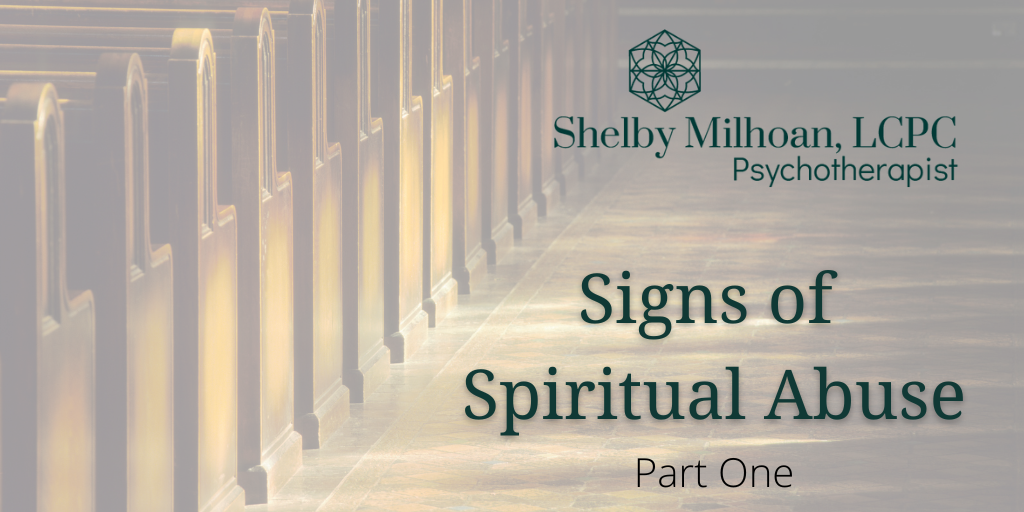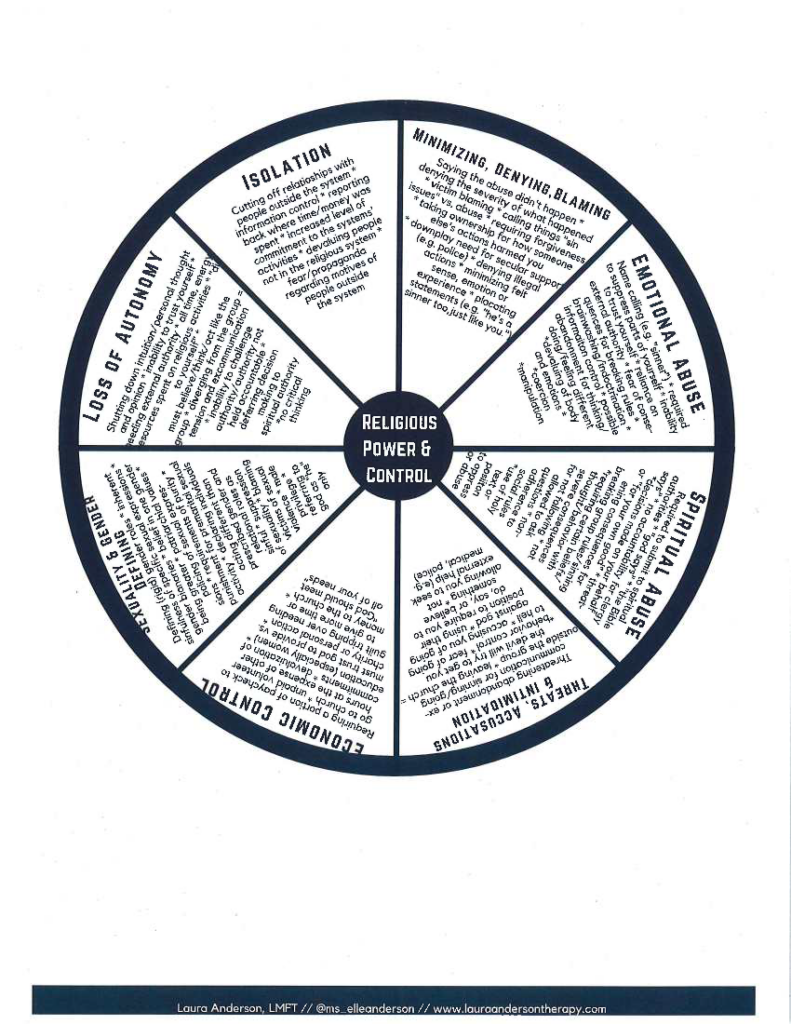
Signs of Spiritual Abuse—Part One
Since I began doing DBT therapy and seeing more clients who have had difficult childhoods, I noticed a theme. As we started peeling back the layers, some seemed to have a history of religious trauma. When I listened to their stories, I was shocked to see a history of suffering coming from core beliefs instilled in childhood and perpetuated by their families’ religiosity. These beliefs and behaviors seem to bring about intense anxiety, fear, and shame in the present. Some of these emotions coincide with ineffective behaviors (think substance abuse, eating disorders, etc.) After noting this, I wanted to learn more about how I could help. I found a CEU put on by The Religious Trauma Institute with the fabulous Dr. Kathryn Keller and Anna Clark-Miller, LPC. The article below is what I took from it, hoping to help inform clients and others that they aren’t alone or “crazy.”
Spiritual Abuse is defined by Ward (2011) as a misuse of power in a spiritual context whereby spiritual authority is distorted to the detriment of those under its leadership.
So basically, we are talking about controlling behavior seen by people (usually people who are in authority) in religious or other groups that harm others within that group. There are a few ways people can look at spiritual abuse. However, I’m going to focus on the Religious Power & Control Wheel developed by The Religious Trauma Institute (RTI) to outline the signs of religious and spiritual abuse in high-control religions (think religious groups that have strict guidelines that harm others, whether that be physically, verbally, or emotionally). This wheel may look familiar if you have seen the power and control wheel used to describe signs of domestic violence. Because it is a lot of information, I have broken this blog into two parts. Part I of this article focuses on four-wheel spokes, and Part II four more.

Coercion and Threat
With spiritual abuse, there are almost always elements of coercion and threat. These threats may be framed as God’s wrath, punishment from other deities, or as not “following the path” and being “lost.” For example, suppose a member would not join in on a service or important meeting. Other members of the group (or those with much power in the group hierarchy) may threaten the member for not attending. They may state, “Well, it seems like you are straying off the path to enlightenment.” or “God is always watching.” There may also be a threat of exclusion from the group. This can be terrifying for someone who relies on the group for emotional, physical, and social safety and growth. This fear keeps members in the group and often leads them to dismiss bodily feelings and sensations meant to protect them. There may also be an element of fear of other mystical forces. Let’s say a member admits to feelings of lust toward another member of the group who is married, which is against religious teachings. They may hear from other members that they are straying and may become “possessed,” or they may be coerced to give penance for such thoughts and emotions through prayer or physical harm to themselves. The threat of going to hell or having an unpleasant afterlife experience keeps members in line. The threats and coercion tactics used above are meant to keep members in the group, obey leaders, and minimize their autonomy.
Spiritual Intimidation/Abuse
Within high-control religions, some specific individuals are seen as having a “Divine Appointment” or authority. These people are said to hold extraordinary power given to them by the divine, and what they say in the group must go. That means members must not question these leaders; if they do, they are threatened. You can think of these individuals with a “divine appointment” as royalty. They often get a “pass” if they don’t follow the rules and are not held accountable for their actions. The appointed can also use religious texts to justify abuse. For example, “God said _____ should be punished.” This spiritual intimidation is also meant to keep members obeying.
Emotional Abuse
This can look like shaming or name-calling, such as calling someone in the group a “sinner” or scolding someone who has disobeyed. Within these groups, unrealistic expectations are set (i.e., do not become angry or jealous). When a member inevitably fails, they will be shamed, and the members within the group will advocate for more profound experiences with the group to “make them good again.” This reinforces control, and the cycle continues. Emotional suppression and invalidation are common within these groups. For example, if a member asks someone of power within the group a question that may threaten control, the person in power may say, “Are you dumb? Why are you even asking that?” In addition, members may be told envy, anger, or other emotions and thoughts are sinful. There is often a villainization of self-love or self-care. Members of high-control religions are often taught not to be selfish or self-centered, leading them to ignore inner emotional experiences and physical sensations that are important for a person’s growth and health.
Isolation
Within high-control religions, there is often limited access to outside support, information, and media control. Members may not be allowed to consult lawyers or doctors outside of the religion or be unable to watch live television. Occasionally, there may be physical isolation, seen in communes or when a group buys up all the houses in one area and lives there. In addition, psychological isolation can be seen as members feeling “internally different.” Members are told that people outside of the group are not safe. They may mock and dehumanize others or share propaganda inciting fear, leading to intense feelings of loneliness and fear when thinking about leaving the group.
Check out Part II of Signs of Spiritual Abuse to learn about the last 4 spokes of the wheel.

Shelby Milhoan, LCPC
